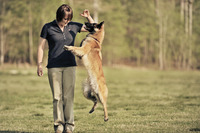Course Details
For true training geeks, who want to obsess over the details of the perfect fold-back down, square tucked sits, fronts and finishes and other precision based exercises.
We will uncover the physiology behind the actions, going much farther than just the final position. HOW does the dog achieve that perfect, square sit? What body parts do what and when? What needs to happen to bring my dog's performance closer to the ideal? And perhaps most importantly, HOW can we tighten down precision while keeping the dog in the game?
Using the science of skill acquisition, we will put these basic, but integral, obedience behaviors under a microscope. Breaking the action down into specific muscle movements. What makes the perfect sit? What makes the perfect down? What tricks or behaviors can modify or access those muscle movements? We will discover that!
We will work on solutions to common nagging problems, like "rabbit feet", rock back sits, floppy or creeping downs. And we will do it by dissecting the problem (yes, science!) and building back the desired behavior with the correct mechanics. Rather than sitting with the feet sticking out (rabbit feet), or sitting with feet out and then tucking them in, can we teach the dog to bring his feet under him straight as his sits in the first place? That will be our focus.
With a solid understanding of the mechanics of these behaviors, we will break down the factors that add challenge when the behaviors are incorporated into exercises. Does your dog sit perfectly square on a platform, but it falls apart when he's retrieving a dumbbell? Does he drop cleanly from a standstill, but take several steps toward you during a drop on recall? We need a plan to split those additional challenges, while still keeping the rate of reinforcement high. Step-by-step, we will develop a plan to integrate these behaviors into our chains and exercises, with the goal of adding speed, arousal, and enthusiasm, while maintaining a high level of precision.
Sneak peak of the sort of geekery you can expect to see:
 Instructor: Hannah Branigan
Instructor: Hannah BraniganHannah Branigan (she/her) has been training dogs and teaching people for more than 10 years. She is a Certified Professional Dog Trainer (CPDT-KA) and a Karen Pryor Academy Certified Training Partner (KPA-CTP). Hannah is the owner of Wonderpups, LLC, and teaches workshops...(Click here for full bio and to view Hannah's upcoming courses)
